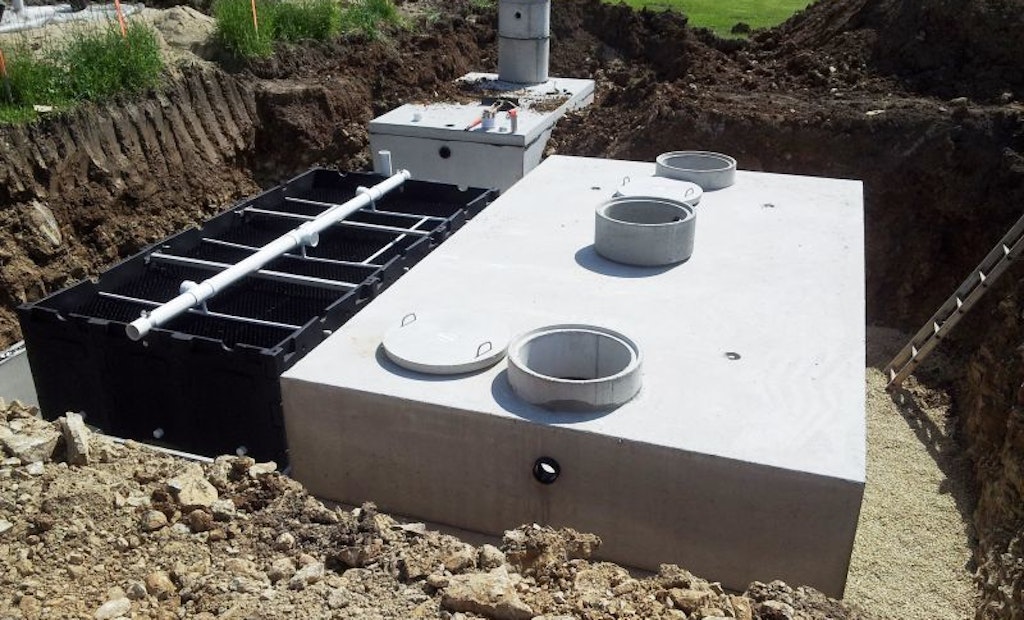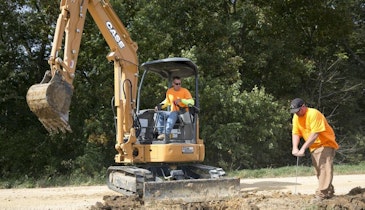Interested in Plumbing?
Get Plumbing articles, news and videos right in your inbox! Sign up now.
Plumbing + Get AlertsConcrete tanks are a standard in the wastewater industry, but when you confront one in the field, how do you know if it has a problem? Fortunately, they’re pretty easy to spot, says one industry expert. And if you do find a problem, odds are you won’t have to replace the tank.
Aaron Ausen, vice president of Dalmaray Precast Concrete Products in Janesville, Wisconsin, has been in the precast industry for 18 years. He started by sweeping floors at the company his family owns, moved up to production, and had some engineering classes along the way.
Concrete tanks are not immune to problems, but they are extremely stable and sustainable, Ausen says. “If a tank is put in a proper location, bedded properly, backfilled, it should last the life of the house. I would say you should not have any issues for 20 or 30 years. I’ve heard people say some of our company’s tanks have been in the ground for 60 or 70 years with no issues.”
Looking for issues is relatively simple. One is penetration by roots, which over the years will pry and push until they’re inside a tank. This persistence can even separate a concrete riser from the tank, and that is no easy task. The sealant used to join those two pieces together is so strong that his guys have sometimes lifted an entire tank while attempting to pull off a riser, meaning the entire load was held by the sealant, Ausen says.
You may prevent problems by observing what plants are located near a tank when you walk up for an inspection. For example, tree roots can be twice as long as the trunk. “This comes from a friend of mine who digs up trees for a living,” Ausen says. In other words, your customers need a clear zone that no deep roots will disturb.
Signs of trouble
Another sign of a septic system problem is a water leak — either infiltration, exfiltration or internal. If you do find a leak, it needs to be addressed immediately. Bear in mind that what looks like a leak may not be one. Even with modern tools, it’s still hard to see what’s really happening inside a tank, Ausen says. He knows a case where a suspected leak turned out to be a homeowner who didn’t realize how much water he used in the course of a day. Monitoring pump operation and water flow can help discern whether a leak is real or imaginary.
Other than these obvious signs, there isn’t much to look for. The bend needed to produce a crack is too slight for your eye to discern, Ausen says. But there are spots where a tank is more likely to crack. Deformation typically happens in a wide U, with the upright portions at the tank corner and the bottom of the U near the bottom of the long wall.
A change in loading can cause deformation. It could be the result of piling several feet of soil on top of a tank buried only 2 feet in the ground, or adding a parking lot on top of a tank. If you know the environment around a tank is about to change in this way, it’s best to consult a precaster to ensure that the tank can handle the additional load.
If it’s broke, fix it
Even though a water leak demands immediate attention, the presence of one does not require replacement of a tank. In fact, unless the loading conditions of the tank have been changed beyond the tank’s original design by something like a parking lot, almost any problem short of total collapse can be repaired, Ausen says. Most septic system failures are caused by system components other than the tank. “I would suggest removing a tank only if it has really serious issues, and in those cases there will probably be more issues in the drainfield than the tank, meaning the whole system should be replaced.”
Even exposed rebar is not a criterion for replacement. It takes a very long time for rebar to degrade to the point where it fails. Look at highway bridges, Ausen says. Bridges missing chunks of concrete and with exposed, rusting rebar are repaired and not replaced.
If you do have a tank leak, what you choose to repair a tank with is very important. There are many products on the market, each suitable for a particular situation. For example, if you have a continuous leak, you want a hydrophilic product because it will expand and immediately stop the flow of water. But if the leak point is dry, a hydrophilic compound won’t work because there is no water to activate it.
There’s an important part of the repair process that Ausen emphasizes: Hire a professional. Precasters don’t do highly specialized installation work, and it is a specialist’s job – to select the right product for the situation, apply it, and of course to adhere to OSHA and local safety regulations about entering confined spaces.
Concrete tanks are no longer simple things, if they ever were. They have always been produced by people with deep knowledge of the process, and lately precasters have included test protocols and the specialty knowledge of structural engineers, Ausen says.
“The product that we make these days is tenfold better than it was back in the day.”
Attention and proper care can keep it that way.






